
Theodore Payne (June 19, 1872 - May 6, 1963), was an English horticulturist, gardener, landscape designer, and botanist. His best known work was done over his adult life in Southern California.

Theodore Payne (June 19, 1872 - May 6, 1963), was an English horticulturist, gardener, landscape designer, and botanist. His best known work was done over his adult life in Southern California.
Payne was born at Manor Farm, Church Brampton, Northamptonshire, England on June 19, 1872. Payne was orphaned and sent to Ackworth School and then served an apprenticeship in horticulture. He first saw California native plants in London, at The Royal Botanical Gardens at Kew in 1891. Payne was apprenticed for three years to J. Cheal and Sons, a nursery firm in Crawley, Sussex. [1]
In June 1893 Payne completed his contract and traveled to the United States. He arrived in New York, traveled to Chicago where he visited the World's Columbian Exhibition, then set out for Southern California. Upon arriving in 1893, he worked for a week picking apricots, then in July found a job as head gardener for Madame Helena Modjeska at "Arden." her ranch estate in Santiago Canyon of eastern Orange County. In his memoir, Life on the Modjeska Ranch in the Gay Nineties , he offers perhaps the best account of daily life on the Modjeska Ranch. It was there that he began his lifelong interest in California native plants, exploring the extensive natural areas surrounding the Ranch. [1]
In 1898, Payne left the employment of Madame Modjeska for a position with the Germain Seed Company. He remained with this firm for five years, becoming head of the seed department. He started his own business in 1903 when he purchased the Evans Nursery in Downtown Los Angeles. California native wildflower seeds and bulbs and native plants were the specialty of his plant nursery business. His nursery location moved several times before settling permanently on Los Feliz Boulevard in Atwater Village in 1923, a few miles north of downtown Los Angeles. The main nursery building was designed by architect Myron Hunt. [1]
Even in the early years of the 20th century, native habitats were being lost to agriculture and housing at an alarming rate in California. He urged the use of California native plants and lectured across the state on preserving the wild flowers and landscapes native to California. In 1907 Payne married Alice Noyes in San Francisco, a marriage of 56 years. [1]
In 1915 he laid out and planted 262 species in a 5-acre (20,000 m2) wild garden in Exposition Park, in central Los Angeles. In 1926 he helped to establish the Blaksley Botanic Garden (Santa Barbara Botanic Garden) in Santa Barbara, In 1939 he created native plant garden with 178 plant species at the California Institute of Technology in Pasadena.
He assisted Susan Bixby Bryant in 1927 with the siting and design of the original Rancho Santa Ana Botanic Garden in Orange County, and helped relocate the Garden to Claremont in 1951. In 1958 he helped create the native plant garden at Descanso Gardens in La Cañada. [1]
By the time he retired in 1958, Payne had introduced over 430 species of native plants to the public through his nursery. Theodore Payne died on May 6, 1963. [1]
He was a founding member of the California Association of Nurserymen—CAN, the Wild Flower Club, the Nature Club, and other horticultural organizations. He was a member of the Southern California Academy of Sciences, including serving as president of the organization. He was a member of many other local horticultural, scientific, and social organizations.
The Theodore Payne Foundation for Wild Flowers and Native Plants was founded and incorporated in 1960 upon Payne's retirement to carry on his life's work. The Foundation is located in Sun Valley, California, a community in the City of Los Angeles. [1]
The Foundation promotes the understanding and preservation of California native flora by propagating plants for use by the general public, through educational programs related to the horticulture and botany of the flora, with the display of botanical art depicting the flora, among other programs. The Foundation hold Payne's business and personal papers, an archive that provides insight to the horticultural history of California.

Lapageria is a genus of flowering plants with only one known species, Lapageria rosea, commonly known as Chilean bellflower or copihue. Lapageria rosea is the national flower of Chile. It grows in forests in the southern part of Chile, being part of the Valdivian temperate rain forests flora.
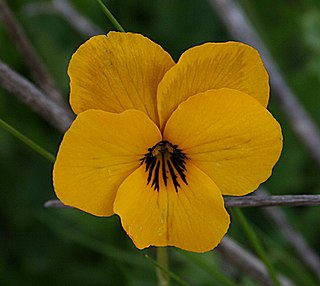
Viola pedunculata, the California golden violet, Johnny jump up, or yellow pansy, is a perennial yellow wildflower of the coast and coastal ranges in California and northwestern Baja California. The common name "Johnny jump up" is usually associated with Viola tricolor however, the introduced garden annual.

Dudleya virens, the green liveforever or bright green dudleya, is an uncommon species of perennial, succulent plant in the family Crassulaceae, native to several coastal southern California and Baja California locations.

Sonoma Botanical Garden is a 501(c)3 private nonprofit education and research botanical garden home to one of the largest collections of scientifically documented, wild-source Asian plants in North America and Europe.

Calycanthus, called sweetshrub, is a genus of flowering plants in the family Calycanthaceae. The genus includes two to four species depending on taxonomic interpretation; three are accepted by most 21st century sources.

Fremontodendron californicum, with the common names California flannelbush, California fremontia, and flannel bush, is a flowering shrub native to diverse habitats in southwestern North America.

Frangula californica is a species of flowering plant in the buckthorn family native to western North America. It produces edible fruits and seeds. It is commonly known as California coffeeberry and California buckthorn.
The Theodore Payne Foundation for Wild Flowers and Native Plants — or TPF, is a private, non-profit organization founded in 1960 to promote the understanding and preservation of California native plants. It continues the work of Theodore Payne, an English horticulturist, gardener, landscape designer, and botanist.

Ceanothus arboreus is a species of perennial shrub to small tree in the family Rhamnaceae, commonly known as the felt-leaf ceanothus, island ceanothus, and island mountain lilac. It is the largest member of the California lilacs, and is characterized with glossy, dark green foliage that is adorned by pale blue to white flowers in bloom. It is endemic to the Channel Islands of California and Guadalupe Island in Mexico, only being re-discovered on Guadalupe Island after the elimination of feral goats.

Ornithostaphylos is a monotypic plant genus which contains the single species Ornithostaphylos oppositifolia, commonly known as the Baja California birdbush or Baja California manzanita. A large, evergreen shrub in the heather family, this species is near-endemic to northwestern Baja California, with a small population just north of the border in San Ysidro, California. It produces a much-branched inflorescence of white, urn-shaped flowers, and has leathery leaves that appear opposite or in whorls. These unique characteristics separate it from its close relatives in the region, which include manzanitas (Arctostaphylos), summer holly (Comarostaphylis) and mission manzanita (Xylococcus).
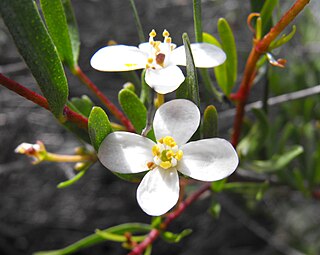
Cneoridium is a monotypic genus in the citrus family which contains the single species Cneoridium dumosum, commonly known as bushrue or coast spice bush. This perennial, evergreen shrub is native to the coast of southern California and Baja California, thriving in hot, dry conditions. This plant is characterized by a distinctive citrusy aroma and small, white flowers that appear from winter to spring. The flowers eventually become round berries that resemble a miniature version of the common citrus fruit.

Eriogonum arborescens is a species of wild buckwheat known by the common name Santa Cruz Island buckwheat.

Eriogonum cinereum is a species of wild buckwheat known by the common names coastal duckwheat and ashyleaf duckwheat.

Juncus patens is a species of rush, known by the common names spreading rush and California grey rush.

Sambucus racemosa is a species of elderberry known by the common names red elderberry and red-berried elder.
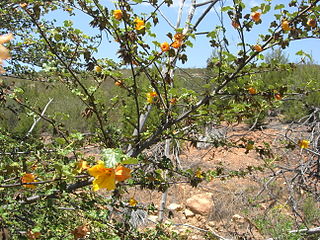
Fremontodendron mexicanum is a rare species of shrub in the mallow family known by the common names Mexican flannelbush, Mexican fremontia, and Southern flannelbush, that is endemic to the central Peninsular Ranges in Mexico and the United States.
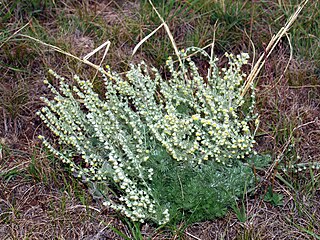
Artemisia frigida is a widespread species of flowering plant in the aster family, which is known as the sunflower family. It is native to Europe, Asia, and much of North America. In parts of the north-central and northeastern United States it is an introduced species.
Lester Gertrude Ellen Rowntree (1879–1979), a renowned field botanist and horticulturalist, was a pioneer in the study, propagation, and conservation of California native plants. In numerous journal and magazine articles, books, and public lectures, she shared her extensive knowledge of wildflowers and shrubs while arguing tirelessly for their protection.
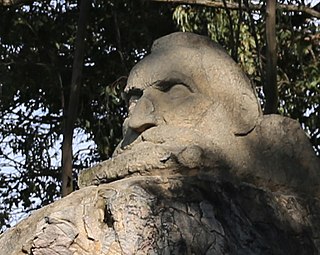
Francesco Franceschi (1843–1924) – known in Italy by his title and birth name of CavalierEmanuele Orazio Fenzi – was an Italian banker and horticulturist who spent part of his later career in the United States, where his efforts contributed to the introduction of new plant species in southern California.